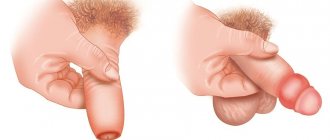Physiological phimosis in children and its manifestations
In order to understand what physiological phimosis is in children, you first need to know the basics of the anatomical structure of the penis. Normally, the head of the penis is covered by the foreskin, which has a layered structure and from the outside is visually no different from the skin, despite the fact that inside it is a mucous membrane. This device ensures soft sliding of the foreskin, allowing you to freely expose the head of the penis.
Doctors call phimosis a narrowing of the foreskin, in which releasing the head requires effort, and sometimes is not possible at all. Phimosis in newborn boys is considered a physiological norm and is not a pathological condition. At the age of 4-6 years, the foreskin of the child’s penis is fused to the head with special adhesions called synergies, which is considered a manifestation of physiological phimosis in children. This condition serves as a barrier mechanism that protects the prepuncial space from infectious contamination.
Congenital phimosis in boys usually goes away on its own, during the process of active growth. The head gradually stretches the foreskin, freeing the prepuncial space from adhesions. This mechanism is also regulated by a hormonal factor. The active release of sex hormones helps to give elasticity to the foreskin, which makes it easier to slide.
In rare cases, symptoms of phimosis in boys persist until adolescence. At the same time, parents should understand that persistent narrowing of the foreskin in a child over 6 years of age requires contacting a specialist who will prescribe conservative or surgical treatment for this condition. Attentive attention to the development and health of a boy at this age will help avoid the occurrence of a pathological process.
PARAPHIMOSIS
Paraphimosis is a complication of both congenital and acquired phimosis. If the foreskin, forcefully pulled behind the coronal groove of the penis, is not returned, then it pinches the head of the penis, which causes its swelling. In this case, a partial disruption of blood circulation occurs in the head, which leads to its necrosis. There is pain in the area of the pinched head of the penis, cyanosis and swelling.
To avoid the development of irreversible changes in the glans penis (such as necrosis), the following technique is used. The head of the penis is pressed with the thumbs and gauze soaked in Vaseline oil♠ (or glycerol), and the ring of the foreskin is pulled forward with other fingers.
If the head of the penis can be straightened, the patient is prescribed baths with a slightly pink solution of potassium permanganate until the swelling is completely eliminated. Otherwise, the compressive ring of the foreskin is cut, which helps to free the head (practically, this is the same as cutting phimosis). It is best to perform a circular excision.
The most effective, fastest and safest way to treat phimosis in both children and adults is surgery to circumcise the foreskin of the penis (circumcision). The operation is performed under local anesthesia, which usually takes 20–30 minutes. At the request of the patient, circumcision is performed under general anesthesia. The surgical method allows you to remove the foreskin of the penis and permanently eliminate the morphological substrate of phimosis. However, complications can occur with circumcision, just like with any other surgery.
Recently, a large number of reports have appeared on the possibility of non-operative treatment of phimosis. This method is based on the use of ointments containing male sex hormones, while simultaneously mechanically stretching the foreskin of the penis. In this case, the hormonal ointment causes a decrease in the density of the tissues of the preputial ring and makes it possible to expose the head. The technique is applicable for physiological and cicatricial phimosis up to the stage of formation of a dense scar. The main disadvantage is the long duration - 12 months, as well as absolute ineffectiveness in the late stage of cicatricial phimosis. In this regard, it can be argued that the main method of treating phimosis at present is surgery to circumcise the foreskin of the penis.
Pathological phimosis and possible complications
Lack of hygiene, trauma and inflammation in the penile area can lead to the development of pathological phimosis, which, depending on the reasons for its formation, is divided into two types:
- Atrophic or cicatricial phimosis develops when there is scar tissue on the foreskin, which prevents the skin from stretching;
- Hypertrophic phimosis is characterized by an anomaly of the anatomical structure, in which there is an excess of the foreskin.
Pathological forms of narrowing of the foreskin in children can be accompanied by dangerous complications that require timely medical attention. Children's phimosis, which seems harmless at first glance, requires medical intervention in the following cases:
- Urinary dysfunction . It is manifested by the accumulation of urine in the prepuncial space and its flow out in a thin stream. Accompanied by swelling of the foreskin.
- Acute urinary retention . It occurs as a result of prolonged inability to urinate in a child, due to a reflex reaction to pain. It manifests itself as acute pain in the lower abdomen and an increase in the size of the bladder upon palpation.
- Balanoposthitis . This condition is characterized by inflammation of the head of the penis as a result of bacterial infection of the prepuncial space. Balanoposthitis is a fairly common concomitant of narrowing of the foreskin due to the accumulation in the space between the skin and the head of the penis of biological fluids, such as smegma and urine, which are a favorable breeding ground for pathogenic microorganisms. Untimely treatment of this condition can lead to inflammatory diseases of the genitourinary system, such as cystitis, pyelonephritis, urethritis. Balanposthitis most often becomes a consequence of cicatricial phimosis in boys.
- Paraphimosis is a pinching of the head of the penis as a result of rough manipulations aimed at freeing it from the foreskin. This condition can lead to disruption of the blood supply to tissues due to compression of the blood vessels, which often causes necrosis and suppuration of the head of the penis. This condition requires immediate medical intervention, as it can result in irreversible damage to the tissues of the child’s genital organ.
As a rule, complicated phimosis is painful, causing severe discomfort to the child, and if parents notice it, they should take the boy to a specialist. If a child is diagnosed with pathological phimosis, the doctor will prescribe treatment, which usually begins with conservative methods, only if ineffective, they resort to surgical solutions to the problem.
Phimosis keeps pace with age
In adolescents, young men and adult men, phimosis steadily progresses, this is due to the appearance of erections, masturbation and sexual activity. During an erection, the head of the penis enlarges and the foreskin stretches tightly. In this case, small cracks and microcracks appear on the foreskin; they do not bleed and do not cause any concern. But as they heal, a scar or microscar forms in their place. Scar tissue is less elastic than normal foreskin tissue, therefore, with the appearance of each new scar, the foreskin narrows more and more, and the disease progresses. This process is especially pronounced during sexual intercourse; ruptures of the foreskin can be significant and accompanied by heavy bleeding.
Stages of development
According to the severity of the process, 4 degrees of phimosis are distinguished:
- In a calm state, the head is completely released; during an erection, its removal is difficult and painful;
- At rest, the head of the penis is difficult to remove; during erection, it is completely covered by the foreskin and cannot be released;
- The head can be partially withdrawn only at rest;
- The head is constantly hidden by the foreskin and is not visible. During urination, urine first fills the preputial sac and only then is released drop by drop.
BALANOPOSTHITIS
A purulent inflammatory disease that develops due to poor hygiene of the penis. This develops infrequently in children, because in very young boys, the discharge from the penis and mucous membranes contains almost no harmful bacteria. With age, smegma (the secretion produced by the mucous membrane of the foreskin) begins to have an increasingly complex composition, so hygiene must be more careful. And this is difficult, if the foreskin remains impossible to retract, balanoposthitis may develop.
When is surgery needed?
In many children, physiological phimosis gradually decreases and goes away on its own, without requiring any treatment, much less surgery. Therefore, if nothing bothers the child, it is quite possible to do without surgical intervention. But there are cases when surgery for phimosis in boys is necessary:
- inflammation is regular, and treatment of phimosis does not produce results;
- urination becomes painful;
- adhesions form between the head and foreskin;
- severe swelling with paraphimosis;
- phimosis does not go away until puberty.
If one of the reasons suits you, do not panic too much; in fact, the operation for phimosis is simple, done under local anesthesia and takes only a few minutes. And literally in one or two days you will be able to return home.
In case of developed balanoposthitis, conservative therapy includes the following measures:
- warm baths with a solution of potassium permanganate - 5 times a day for 4 days; treatment with furacillin - according to the same scheme;
- introduction of antiseptic ointments into the preputial sac - 3 times a day for 6 days;
- lubricating the affected area with petroleum jelly - 2 times a day, 7 days.
External antibacterial therapy can be different and is determined in each specific case individually. Antibiotic-based emulsions and powders may be prescribed. When performing the procedure, the foreskin must be moved from the head.
Classification
It should be understood that phimosis is not a disease, but a special condition that is associated with the physiological characteristics of the body (age), heredity and damage to the tissue of the foreskin. In this regard, the following forms of phimosis are distinguished:
- Physiological – occurs in most boys before the onset of puberty, and is associated with the functional maturation of the preputial cavity. It is not a pathology and resolves on its own after 7 years.
- Pathological – occurs as a result of inflammation, injury, metabolic disorders and requires treatment;
- Hypertrophic (proboscis);
- Atrophic;
- Scar.
The incidence of one form or another of phimosis directly depends on age. In children, in the overwhelming majority of cases, it is physiological in nature, and in men it is caused by cicatricial changes.
Treatment
The main treatment method is circumcision. The indication for surgical treatment is the presence of cicatricial phimosis.
However, there are contraindications to circumcision, or circumcision, namely: hypospadias, hidden penis. Also, the operation cannot be performed in the presence of local infections or coagulopathies: in such cases, surgical treatment is carried out after correction of concomitant diseases to eliminate the increased risk of infectious and other complications after surgical treatment.
There are also non-operative treatment methods for mild forms of the disease. In this case, hormonal ointments are used locally, on the area of the foreskin, and mechanical stretching of the foreskin is performed. These treatments are aimed at eliminating the inflammatory process and preventing the possibility of new scars forming. However, conservative treatment is not always appropriate and effective, so the choice of treatment method can only be determined during a face-to-face consultation with a specialist.










